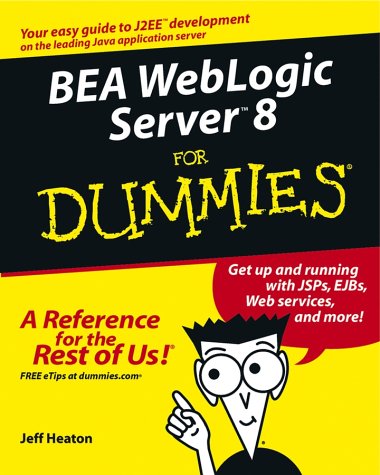Jeff Heaton, Melody Layne9780764524721, 0764524720
Table of contents :
Cover……Page 1
Contents at a Glance……Page 10
Table of Contents……Page 12
Conventions Used in This Book……Page 20
What You Don¡¯t Have to Read……Page 21
Part I: Installing and Configuring WebLogic……Page 22
Part V: Big- Time, Heavy- Duty Server Configuration……Page 23
Where to Go from Here……Page 24
Part I: Installing and Configuring WebLogic……Page 26
Application Server Basics……Page 28
Achieving reliability through redundancy……Page 29
Improving modularity……Page 30
Enterprise JavaBeans……Page 31
Enterprise applications……Page 32
EJB support……Page 33
Web services……Page 34
Security……Page 35
Installation Overview……Page 36
System requirements……Page 37
Getting WebLogic……Page 38
Understanding licensing……Page 39
Using the GUI Mode Installer……Page 40
Using Configuration Wizard……Page 43
Using the Console Mode Installer……Page 45
Installing under UNIX……Page 46
Installing under Windows……Page 47
Using the Silent Mode Installer……Page 48
Creating a template file……Page 49
installation program……Page 53
Writing a WebLogic Startup Script……Page 54
The standard startup script……Page 55
Constructing your own startup script……Page 56
Windows Start Menu……Page 58
Configuring WebLogic as a Windows service……Page 59
Running WebLogic as a UNIX daemon……Page 62
4: Configuring and Administering WebLogic……Page 64
Understanding Domains, Clusters,Servers, and Machines……Page 65
Logging on to Administration Console……Page 66
Using Administration Console……Page 67
Defining Network Channels……Page 69
Introducing Node Manager……Page 72
Setting up the Node Manager hosts file……Page 73
Configuring SSL for Node Manager……Page 74
Configuring a control machine to use Node Manager……Page 75
Configuring startup arguments for managed servers……Page 77
Starting Node Manager using start scripts……Page 79
Setting Node Manager environment variables……Page 80
Monitoring the Server……Page 83
Part II: Understanding WebLogic Components……Page 86
Server Basics……Page 88
Setting Up a Web Application……Page 89
Creating your web application……Page 90
Testing your web application……Page 92
Packaging your web application……Page 93
Deploying your web application……Page 94
Web Application……Page 96
The Files in a Web Application……Page 97
Using JSP……Page 98
A quick look at servlets……Page 101
Using JSTL……Page 102
6: Using EJBs……Page 106
Creating the remote interface……Page 107
Creating the home interface……Page 108
Creating the bean class……Page 109
Creating deployment descriptors……Page 110
Creating the client class……Page 112
Building the Stateless Session Bean EJB……Page 113
Deploying the Stateless Session EJB……Page 116
Testing the Stateless Session EJB……Page 117
Adding State……Page 118
Accessing Data with Entity Beans……Page 123
Configuring Message- Driven Beans……Page 124
Database Access……Page 126
Creating the data source……Page 128
Constructing the home interface……Page 131
Constructing the bean implementation……Page 132
Constructing the bean configuration files……Page 137
Compiling a BMP Bean……Page 139
Constructing the value objects……Page 142
Constructing the local bean interfaces……Page 144
Constructing the local home interfaces……Page 145
Constructing the remote home interface……Page 146
Constructing the abstract bean implementation……Page 147
Constructing the bean configuration files……Page 150
Compiling a CMP Bean……Page 156
8: Stepping Up to Enterprise Applications……Page 158
The structure of the WebLogic directory……Page 159
Examining the directory structure……Page 161
Creating Deployment Descriptors……Page 162
Understanding deployment descriptors……Page 163
Creating descriptors using tools……Page 164
Creating descriptors manually……Page 165
Packaging Your Enterprise Application……Page 168
Deploying Your Enterprise Application……Page 169
Part III: Employing Web Services……Page 172
9: Building and Deploying Web Services……Page 174
Defining a Web Service……Page 175
Backend Component……Page 176
Working with a Java class backend component……Page 177
Working with a stateless session EJB backend component……Page 178
Building an Asynchronous Web Service……Page 180
Packaging a synchronous service……Page 181
Deploying Your Web Service……Page 187
Using a Static Client……Page 192
Understanding WSDL……Page 193
Generating the client stub……Page 194
Building the client application……Page 195
Running the client application……Page 198
Constructing the dynamic client……Page 199
Running the dynamic client……Page 201
Creating a Web Service……Page 202
Creating a Workshop application and a web service……Page 203
Adding methods to your web service……Page 204
Testing your web service……Page 208
Debugging Web Services……Page 212
Directory locations……Page 214
Packaging a web service……Page 215
Packaging for a different host……Page 216
Deploying web services……Page 217
Part IV: The Forgotten Services……Page 220
Creating a Connection Pool……Page 222
Defining a Data Source……Page 225
Using JDBC with EJBs……Page 227
Obtaining the connection……Page 231
Closing the data source……Page 232
Using prepared statements……Page 233
Submitting a query……Page 234
Monitoring JDBC……Page 235
Understanding JNDI……Page 238
Understanding JNDI names……Page 239
JNDI as a universal naming service……Page 240
Making WebLogic resources available through JNDI……Page 241
Enabling JNDI to access WebLogic objects……Page 244
Understanding Transactions……Page 248
Two- phase commit……Page 249
When to use transactions……Page 250
When not to use transactions……Page 251
Importing packages……Page 252
Starting the transaction……Page 253
Updating the database……Page 254
Completing the transaction……Page 255
15: Sending Messages Between Programs with JMS……Page 258
Creating a WebLogic Message Service……Page 259
Creating a connection factory……Page 260
Defining a backing store……Page 263
Defining destination keys……Page 265
Defining templates……Page 267
Creating a JMS server……Page 269
Creating queues and topics……Page 271
Accessing Your Message Service……Page 272
Connection……Page 273
Message……Page 274
Creating a Point- to- Point JMS Client……Page 276
Creating the receiver……Page 277
Creating the sender……Page 279
Creating the subscriber……Page 282
Creating the publisher……Page 284
Part V: Big-Time, Heavy-Duty Server Configuration……Page 288
Understanding Clustering……Page 290
Performance through clustering……Page 291
Components of WebLogic Clustering……Page 292
Clustered JDBC……Page 293
Configuring WebLogic Clustering……Page 294
Creating a clustered domain……Page 295
Starting the WebLogic Server cluster……Page 302
Configuring Node Manager……Page 303
Configuring proxy plug- ins……Page 304
Configuring clustered JDBC……Page 307
WebLogic Server Performance Packs……Page 308
Setting thread count……Page 310
JDBC connection pools……Page 314
Caching prepared statements……Page 315
Allocating pool size for session and message beans……Page 316
Setting EJB caching size……Page 317
Setting Your Java Compiler……Page 318
Secure Sockets Layer ( SSL)……Page 320
Obtaining an identity……Page 322
Storing keys and certificates……Page 323
Enabling SSL on your server……Page 326
Introduction to Security Realms……Page 327
Users……Page 328
Groups……Page 330
Security roles……Page 333
Security policies……Page 335
Part VI: The Part of Tens……Page 338
Keep Adequate Documentation……Page 340
Don¡¯t Over- Engineer……Page 341
Set Up Development Environments……Page 342
Create Modular, Decoupled Systems……Page 343
Be Mindful of Security……Page 344
Manage Your Build Process……Page 345
Document Procedures……Page 346
Set Up On- Call Procedures……Page 347
Monitor Your Servers……Page 348
Understand Log Files……Page 349
Test with Clusters……Page 350
Keep WebLogic Up- to- Date……Page 351
Test Your System……Page 352
Conduct a Stress Test……Page 353
Set Up a Bug Tracking System……Page 354
Formulate a Disaster Recovery Plan……Page 355
Be Ready with Support……Page 356
. A …….Page 358
. C …….Page 359
. D …….Page 362
. E …….Page 364
. H …….Page 365
. J …….Page 366
. L …….Page 368
. M …….Page 369
. N …….Page 370
. P …….Page 371
. R …….Page 372
. S …….Page 373
. T …….Page 376
. W …….Page 377
. X …….Page 379







Reviews
There are no reviews yet.